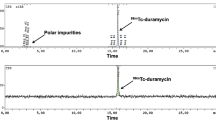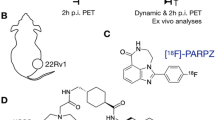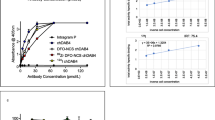Abstract
Purpose
The efficacy of most anticancer treatments, including radiotherapy, depends on an ability to cause DNA double-strand breaks (DSBs). Very early during the DNA damage signalling process, the histone isoform H2AX is phosphorylated to form γH2AX. With the aim of positron emission tomography (PET) imaging of DSBs, we synthesized a 89Zr-labelled anti-γH2AX antibody, modified with the cell-penetrating peptide, TAT, which includes a nuclear localization sequence.
Methods
89Zr-anti-γH2AX-TAT was synthesized using EDC/NHS chemistry for TAT peptide linkage. Desferrioxamine conjugation allowed labelling with 89Zr. Uptake and retention of 89Zr-anti-γH2AX-TAT was evaluated in the breast adenocarcinoma cell line MDA-MB-468 in vitro or as xenografts in athymic mice. External beam irradiation was used to induce DSBs and expression of γH2AX. Since 89Zr emits ionizing radiation, detailed radiobiological measurements were included to ensure 89Zr-anti-γH2AX-TAT itself does not cause any additional DSBs.
Results
Uptake of 89Zr-anti-γH2AX-TAT was similar to previous results using 111In-anti-γH2AX-TAT. Retention of 89Zr-anti-γH2AX-TAT was eightfold higher at 1 h post irradiation, in cells expressing γH2AX, compared to non-irradiated cells or to non-specific IgG control. PET imaging of mice showed higher uptake of 89Zr-anti-γH2AX-TAT in irradiated xenografts, compared to non-irradiated or non-specific controls (12.1 ± 1.6 vs 5.2 ± 1.9 and 5.1 ± 0.8 %ID/g, respectively; p < 0.0001). The mean absorbed dose to the nucleus of cells taking up 89Zr-anti-γH2AX-TAT was twofold lower compared to 111In-anti-γH2AX-TAT. Additional exposure of neither irradiated nor non-irradiated cells nor tissues to 89Zr-anti-γH2AX-TAT resulted in any significant changes in the number of observable DNA DSBs, γH2AX foci or clonogenic survival.
Conclusion
89Zr-anti-γH2AX-TAT allows PET imaging of DNA DSBs in a tumour xenograft mouse model.





Similar content being viewed by others
References
Helleday T, Petermann E, Lundin C, Hodgson B, Sharma RA. DNA repair pathways as targets for cancer therapy. Nat Rev Cancer 2008;8(3):193–204. doi:10.1038/nrc2342.
Bartek J, Bartkova J, Lukas J. DNA damage signalling guards against activated oncogenes and tumour progression. Oncogene 2007;26(56):7773–9. doi:10.1038/sj.onc.1210881.
Cornelissen B, Kersemans V, Darbar S, Thompson J, Shah K, Sleeth K, et al. Imaging DNA damage in vivo using gammaH2AX-targeted immunoconjugates. Cancer Res 2011;71(13):4539–49. doi:10.1158/0008-5472.CAN-10-4587.
Li W, Li F, Huang Q, Shen J, Wolf F, He Y, et al. Quantitative, noninvasive imaging of radiation-induced DNA double-strand breaks in vivo. Cancer Res 2011;71(12):4130–7. doi:10.1158/0008-5472.CAN-10-2540.
Rogakou EP, Pilch DR, Orr AH, Ivanova VS, Bonner WM. DNA double-stranded breaks induce histone H2AX phosphorylation on serine 139. J Biol Chem 1998;273(10):5858–68.
Rothkamm K, Löbrich M. Evidence for a lack of DNA double-strand break repair in human cells exposed to very low x-ray doses. Proc Natl Acad Sci U S A 2003;100(9):5057–62. doi:10.1073/pnas.0830918100.
Ivashkevich A, Redon CE, Nakamura AJ, Martin RF, Martin OA. Use of the gamma-H2AX assay to monitor DNA damage and repair in translational cancer research. Cancer Lett 2012;327:123–33. 10.1016/j.canlet.2011.12.025. doi:10.1016/j.canlet.2011.12.025.
Bartkova J, Horejsí Z, Koed K, Krämer A, Tort F, Zieger K, et al. DNA damage response as a candidate anti-cancer barrier in early human tumorigenesis. Nature 2005;434(7035):864–70. doi:10.1038/nature03482.
Celeste A, Petersen S, Romanienko PJ, Fernandez-Capetillo O, Chen HT, Sedelnikova OA, et al. Genomic instability in mice lacking histone H2AX. Science 2002;296(5569):922–7. doi:10.1126/science.1069398.
Shah K, Cornelissen B, Kiltie AE, Vallis KA. Can γH2AX be used to personalise cancer treatment? Curr Mol Med 2013;13(10):1591–602.
Cornelissen B, Darbar S, Kersemans V, Allen PD, Falzone N, Barbeau J, et al. Amplification of DNA damage by a γH2AX-targeted radiopharmaceutical. Nucl Med Biol 2012;39(8):1142–51. doi:10.1016/j.nucmedbio.2012.06.001.
Cornelissen B, Able S, Kartsonaki C, Kersemans V, Allen D, Cavallo F, et al. Imaging DNA damage allows detection of preneoplasia in the BALB-neuT model of breast cancer. J Nucl Med 2014;55(12):2026–31. doi:10.2967/jnumed.114.142083.
Kersemans V, Kersemans K, Cornelissen B. Cell penetrating peptides for in vivo molecular imaging applications. Curr Pharm Des 2008;14(24):2415–47.
Bailey DL, Willowson KP. An evidence-based review of quantitative SPECT imaging and potential clinical applications. J Nucl Med 2013;54(1):83–9. doi:10.2967/jnumed.112.111476.
Vosjan MJ, Perk LR, Visser GW, Budde M, Jurek P, Kiefer GE, et al. Conjugation and radiolabeling of monoclonal antibodies with zirconium-89 for PET imaging using the bifunctional chelate p-isothiocyanatobenzyl-desferrioxamine. Nat Protoc 2010;5(4):739–43. doi:10.1038/nprot.2010.13.
Cornelissen B, Hu M, McLarty K, Costantini D, Reilly RM. Cellular penetration and nuclear importation properties of 111In-labeled and 123I-labeled HIV-1 tat peptide immunoconjugates in BT-474 human breast cancer cells. Nucl Med Biol 2007;34(1):37–46. doi:10.1016/j.nucmedbio.2006.10.008.
Salvat F, Fernández-Varea JM, Sempau J, editors. PENELOPE: a code system for Monte Carlo simulation of electron and photon transport. OECD Nuclear Energy Agency; 2011; Issy-les-Moulineaux.
Eckerman KF, Endo A. MIRD: radionuclide data and decay schemes. Reston: Society of Nuclear Medicine; 2008.
Goddu SM, Howell RW, Rao DV. Cellular dosimetry: absorbed fractions for monoenergetic electron and alpha particle sources and S-values for radionuclides uniformly distributed in different cell compartments. J Nucl Med 1994;35(2):303–16.
Cornelissen B, McLarty K, Kersemans V, Scollard DA, Reilly RM. Properties of [(111)In]-labeled HIV-1 tat peptide radioimmunoconjugates in tumor-bearing mice following intravenous or intratumoral injection. Nucl Med Biol 2008;35(1):101–10. doi:10.1016/j.nucmedbio.2007.09.007.
Laing RE, Walter MA, Campbell DO, Herschman HR, Satyamurthy N, Phelps ME, et al. Noninvasive prediction of tumor responses to gemcitabine using positron emission tomography. Proc Natl Acad Sci U S A 2009;106(8):2847–52. doi:10.1073/pnas.0812890106.
Hanahan D, Weinberg RA. Hallmarks of cancer: the next generation. Cell 2011;144(5):646–74. doi:10.1016/j.cell.2011.02.013.
Kircher MF, Hricak H, Larson SM. Molecular imaging for personalized cancer care. Mol Oncol 2012;6(2):182–95. doi:10.1016/j.molonc.2012.02.005.
Wahl RL. 2013 SNMMI Highlights Lecture: oncology. J Nucl Med 2013;54(11):11N–22N.
Rahmim A, Zaidi H. PET versus SPECT: strengths, limitations and challenges. Nucl Med Commun 2008;29(3):193–207. doi:10.1097/MNM.0b013e3282f3a515.
Rübe CE, Grudzenski S, Kühne M, Dong X, Rief N, Löbrich M, et al. DNA double-strand break repair of blood lymphocytes and normal tissues analysed in a preclinical mouse model: implications for radiosensitivity testing. Clin Cancer Res 2008;14(20):6546–55. doi:10.1158/1078-0432.CCR-07-5147.
Bourton EC, Plowman PN, Smith D, Arlett CF, Parris CN. Prolonged expression of the γ-H2AX DNA repair biomarker correlates with excess acute and chronic toxicity from radiotherapy treatment. Int J Cancer 2011;129(12):2928–34. doi:10.1002/ijc.25953.
Firsanov DV, Solovjeva LV, Svetlova MP. H2AX phosphorylation at the sites of DNA double-strand breaks in cultivated mammalian cells and tissues. Clin Epigenetics 2011;2(2):283–97. doi:10.1007/s13148-011-0044-4.
Wasco MJ, Pu RT. Utility of antiphosphorylated H2AX antibody (gamma-H2AX) in diagnosing metastatic renal cell carcinoma. Appl Immunohistochem Mol Morphol 2008;16(4):349–56. doi:10.1097/PAI.0b013e3181577993.
Podhorecka M, Skladanowski A, Bozko P. H2AX phosphorylation: its role in DNA damage response and cancer therapy. J Nucleic Acids 2010;2010. doi:10.4061/2010/920161
Djuzenova CS, Elsner I, Katzer A, Worschech E, Distel LV, Flentje M, et al. Radiosensitivity in breast cancer assessed by the histone γ-H2AX and 53BP1 foci. Radiat Oncol 2013;8:98. doi:10.1186/1748-717X-8-98.
Redon CE, Nakamura AJ, Martin OA, Parekh PR, Weyemi US, Bonner WM. Recent developments in the use of γ-H2AX as a quantitative DNA double-strand break biomarker. Aging 2011;3(2):168–74.
Lundholm L, Hååg P, Zong D, Juntti T, Mörk B, Lewensohn R, et al. Resistance to DNA-damaging treatment in non-small cell lung cancer tumor-initiating cells involves reduced DNA-PK/ATM activation and diminished cell cycle arrest. Cell Death Dis 2013;4:e478. doi:10.1038/cddis.2012.211.
Cornelissen B, Able S, Vallis KA. Targeting γH2AX during oncogenesis with Auger electron therapy delays tumor onset. J Nucl Med 2013;54(Suppl 2):121.
Cornelissen B, Waller A, Able S, Vallis KA. Molecular radiotherapy using cleavable radioimmunoconjugates that target EGFR and γH2AX. Mol Cancer Ther 2013;12(11):2472–82. doi:10.1158/1535-7163.MCT-13-0369.
Xie A, Puget N, Shim I, Odate S, Jarzyna I, Bassing CH, et al. Control of sister chromatid recombination by histone H2AX. Mol Cell 2004;16(6):1017–25. doi:10.1016/j.molcel.2004.12.007.
Celeste A, Difilippantonio S, Difilippantonio MJ, Fernandez-Capetillo O, Pilch DR, Sedelnikova OA, et al. H2AX haploinsufficiency modifies genomic stability and tumor susceptibility. Cell 2003;114(3):371–83.
Acknowledgments
The authors sincerely thank Prof. Nicola R. Sibson, Prof. Katherine A. Vallis, and Dr. Sean Smart for their support. We further thank Cancer Research UK, MRC, the Oxford Cancer Research Centre and the CRUK&EPRSC Cancer Imaging Centre in Oxford for financial support.
Ethical approval
All applicable international, national and/or institutional guidelines for the care and use of animals were followed.
Conflicts of interest
None.
Author information
Authors and Affiliations
Corresponding author
Additional information
James C. Knight and Caitríona Topping contributed equally to this work.
Electronic supplementary material
Below is the link to the electronic supplementary material.
ESM 1
(DOCX 464 kb)
Rights and permissions
About this article
Cite this article
Knight, J.C., Topping, C., Mosley, M. et al. PET imaging of DNA damage using 89Zr-labelled anti-γH2AX-TAT immunoconjugates. Eur J Nucl Med Mol Imaging 42, 1707–1717 (2015). https://doi.org/10.1007/s00259-015-3092-8
Received:
Accepted:
Published:
Issue Date:
DOI: https://doi.org/10.1007/s00259-015-3092-8




